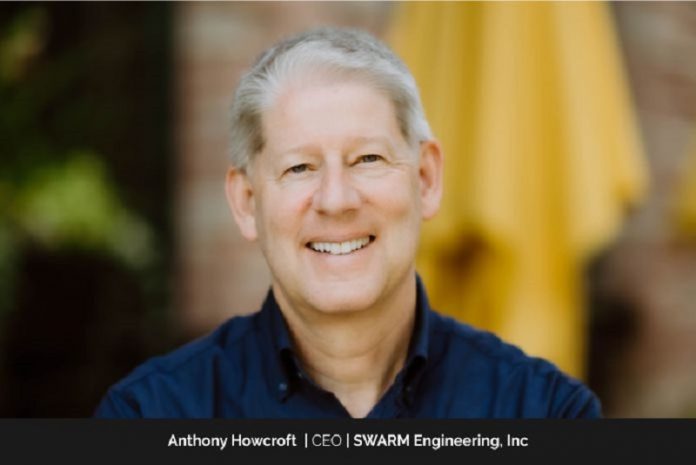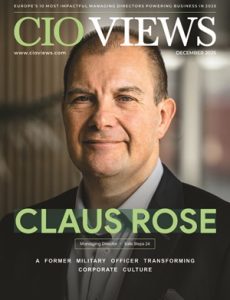Anthony Howcroft, Co-founder and CEO of SWARM Engineering, has amassed over 25 years’ experience in the technology sector, working in a mix of corporate and startup roles that cover software engineering, sales and marketing. He describes himself as being equally at ease with art and science. Anthony went from working as a technical software engineer to product marketing and then sales, finding time to become a prize-winning author along the way.
As the world crosses the threshold of the next generation of cognitive computing, SWARM is enabling enterprise to optimize their processes and for workers to achieve superhuman performance.
SWARM allows customers to model their key processes, such as balancing supply and demand, labor planning, managing inbound or outbound logistics, and applies a multi-agent system with machine learning, to automatically optimize the process.
“I became fascinated by the concept of solving problems directly, and saw that possibility as the next evolution of BI, fueled by AI.”
An entrepreneur & bestselling author
Anthony grew up in a predominantly agricultural community in the center of England, where his first job was as a mainframe computer operator at Kraft Foods. “I went straight from school to work as a computer operator on an IBM mainframe system, moving into programming a year later,” he recalls.
The Universities in England at that time were only offering math-based courses that helped build computers, and Anthony felt it was more interesting to see what he could do with them, being more interested in the application of the technology than how to build it. From there, he dove headfirst into the tech sector and never looked back.
He gained experience in starting a business and leading a team as co-founder and VP Sales of DATAllegro – a data warehouse appliance vendor acquired by Microsoft for $260M in 2008.
Anthony then ran Microsoft’s Big Data team in EMEA for five years, showing triple digit growth each year. He also got to meet many different organizations looking to make best use of their data.
“I saw that while many companies were seeking actionable insights on their information, what that often meant was identifying problems which they would then have to go and solve. I became fascinated by the concept of solving problems directly and saw that possibility as the next evolution of BI, fuelled by AI,” he says.
From there, Anthony joined a start-up incubator and spent some time mentoring CEOs in Southern California. While working there, he had a conversation with the CTO of a GE business division. They began discussing how IoT might result in a ‘Facebook for machines’; and that these social networks of machines might use data + AI to solve their own problems.
That was the seed from which SWARM grew. With this knowledge – combined with the skills learned from undertaking a Creative Writing Diploma at the University of Oxford – Anthony wrote a non-fiction book titled “Questions: A User’s Guide,” which was published in October 2020. Not only did it achieve Amazon bestseller status, but the research behind the book is being used to enhance the approach of the SWARM Challenge Modeler product. Anthony admits that, while he’s always a little suspicious of public recognition, as it can be two-edged sword, he was delighted when his book made it on to the Amazon best-seller list.
“Recognition means the most when it comes from customers, partners, or employees; when you’ve done something that has made a positive impact for them, and they thank you. That type of recognition is energizing,” he observes.
Helping business save money while saving the world
SWARM helps businesspeople solve operational challenges in the agri-food supply chain, for multi-million-dollar savings. It is a Software-as-a-Service, with three core elements.
The first is the SWARM Challenge Modeler. This is a unique tool, designed for business users to define a problem in their organization, simply and easily. The firm has templates built by subject matter experts for common food supply chain problems, and they are incredibly flexible, so you can start by filling one of these in, editing it, or create your own definition from scratch. You can then publish the result into a beautiful document that can be shared with anyone you choose.
Second, the SWARM Solution Engine is a sophisticated multi-agent system that can run an array of algorithms to solve challenges defined in the Modeler. It is fully scalable and can combine multiple optimizations to solve end-to-end holistic processes, and not just solve problems in silos.
The third piece of the product, the SWARM Ops Dashboard, is how the end user interacts with the engine. This has a modern, intuitive interface that lets people run solutions, change parameters, experiment with what-if scenarios, and ultimately publish executable plans to other users or applications.
Anthony admits that he doesn’t see success as a destination, with an Oscar or a Nobel Prize at the end, he encourages his team to celebrate all of the small successes on their journey; every customer win, positive product review, or press accolade.
Ultimately, he likes to think that SWARM Engineering can change the way people think about their challenges and be a catalyst to help improve a billion processes across the world.
“If we did that, we would be contributing towards carbon reduction, eradicating food waste, or more importantly, hunger, enhancing regenerative-ag processes, and helping other organizations do the right thing and save money at the same time. That would certainly be a success, but so would each of those positive steps on the journey,” says Anthony.
He notes that SWARM can enable business users to make transformational improvements to their critical processes and explained why they focus on the agri-food supply chain.
“The food supply chain is such a fundamental part of the world, with so many opportunities to improve, that we think this is a fabulous way to make a mark. Mind you, there are other industries that could do with a hand too, but for now we are laser-focused on agri-food,” he observes.
In the next few years Anthony hopes to see SWARM Engineering become the de-facto way that agri-food companies meet their critical business challenges; the first person they turn to when they need to improve their processes.
“Ultimately, I see that we could take this approach to other markets too, possibly starting with adjacencies like water and energy. That’s an exciting journey, and there’s nowhere I’d rather be than here in the driving seat, helping steer the company down that road. My goal as a leader is always to hire great people and delegate more to them!” he declares.
Forming better partnerships between humans & machines
Anthony observes that the team at SWARM loves challenges, as their product has been designed to help people capture and clearly define their challenges, so that they can rapidly solve them using the latest AI approaches.
He also hopes to form a better partnership between humans and machines that plays to everyone’s strength and sees the potential to create a generational shift in the way people look at problem-solving.
“When it comes to solving problems, everyone is very focused on solutions. But as Einstein said, the importance of clearly defining a problem is critical. People are great at asking questions, and AI is superb at answering them,” he remarks.
SWARM aims to help everyday people get better at defining problems in a way that lets AI solve these challenges automatically. This is something not currently addressed in the market, and it’s what allows SWARM to stay ahead of the competition due to a unique and unmatched offering.
Anthony points out that one of the most disruptive changes coming to software development is no-code. The ability to bring advanced AI, Machine Learning and Operational Research algorithms into the hands of everyday people, without them needing a degree in math, or years of software development expertise to use it, is “amazing”, as he puts it.
“Counter-intuitively, this is a huge opportunity to get more people involved in coding, although they won’t realise they are doing it! SWARM is delighted to be at the forefront of this revolution,” he states. “It enables people to define problems in their own familiar terms, and then solve these challenges. We have seen some false dawns of no-code in the past, but I think with the current state of AI, this wave of technology is here to stay and will keep getting better.”
Growing into the founder CEO role with creativity & drive
Anthony is constantly working to improve everything he does, and those around him. “I think at heart most entrepreneurs are creators. They want to build and improve the world, to leave it a better place because of the efforts of themselves and their teams. I got into technology because it allowed to me to combine art and science in a creative way,” he says.
When the company is small, as a co-founder and CEO, you do everything. You have to get out of your comfort zone to handle tasks you are not familiar with, such as building a P&L and cash flow model or understanding how your engineering team is using Jira and Github.
Anthony feels that he was lucky in that he’d done so many roles before becoming a founder CEO and was familiar with the business and technology aspects. So, for him the new stuff was fundraising, understanding warrants, the different type of stock grants, how to price a round, when to do a convertible note, and more of the venture aspects.
“I’d been in plenty of companies where that was going on, but you need to do it yourself to really understand it. As a startup grows, the CEO naturally sheds various aspects of their role, delegating to others as the team expands. Sometimes that can be a relief, and other times – especially if it is an area of your expertise – it can feel like handing over your baby to another person. Right now, my primary responsibilities are leadership, fund-raising, and helping guide the product vision,” he explains.
Anthony points out that technology never stands still; and while he rode the wave of software development, aspiring business minds with an interest in tech could start looking at bioengineering, genetics, and CRISPR technology.
“Either way, the most important thing is that you have to be excited by it. My advice would be to immerse yourself in a subject you’re passionate about yet find time to look at other disciplines and areas. True creativity and leaps forward in tech have come when people combine ideas from different genres,” he advises.
Keep learning, improving, creating & inspiring others
Anthony recalls that he’s faced so many personal and professional challenges throughout his career, that he’s hard pressed to highlight any one specifically.
“What I do know is that each of them was an opportunity to learn, and to grow. If you are not failing some of the time, you are not really pushing the boundaries and trying hard enough. The lean startup mantra is ‘fail fast’, which is really about testing your assumptions before you get too far along, so you can adapt. I think that’s a great philosophy,” he observes.
Anthony notes that he’s really competitive, both inside and outside of work. “I like running as a release, play classical guitar to relax, and personally, I find it hugely rewarding to create things, whether that’s a company, a product, or a story,” he remarks.
For Anthony, seeing a product come together from a series of whiteboard sessions, some sketches and a PowerPoint is fantastic. Then watching customers experience that product and use it to deliver lasting value to their organization is rewarding. “What motivates me is to keep learning, improving, creating, and to see the fruits of that labor inspiring others,” he concludes.





